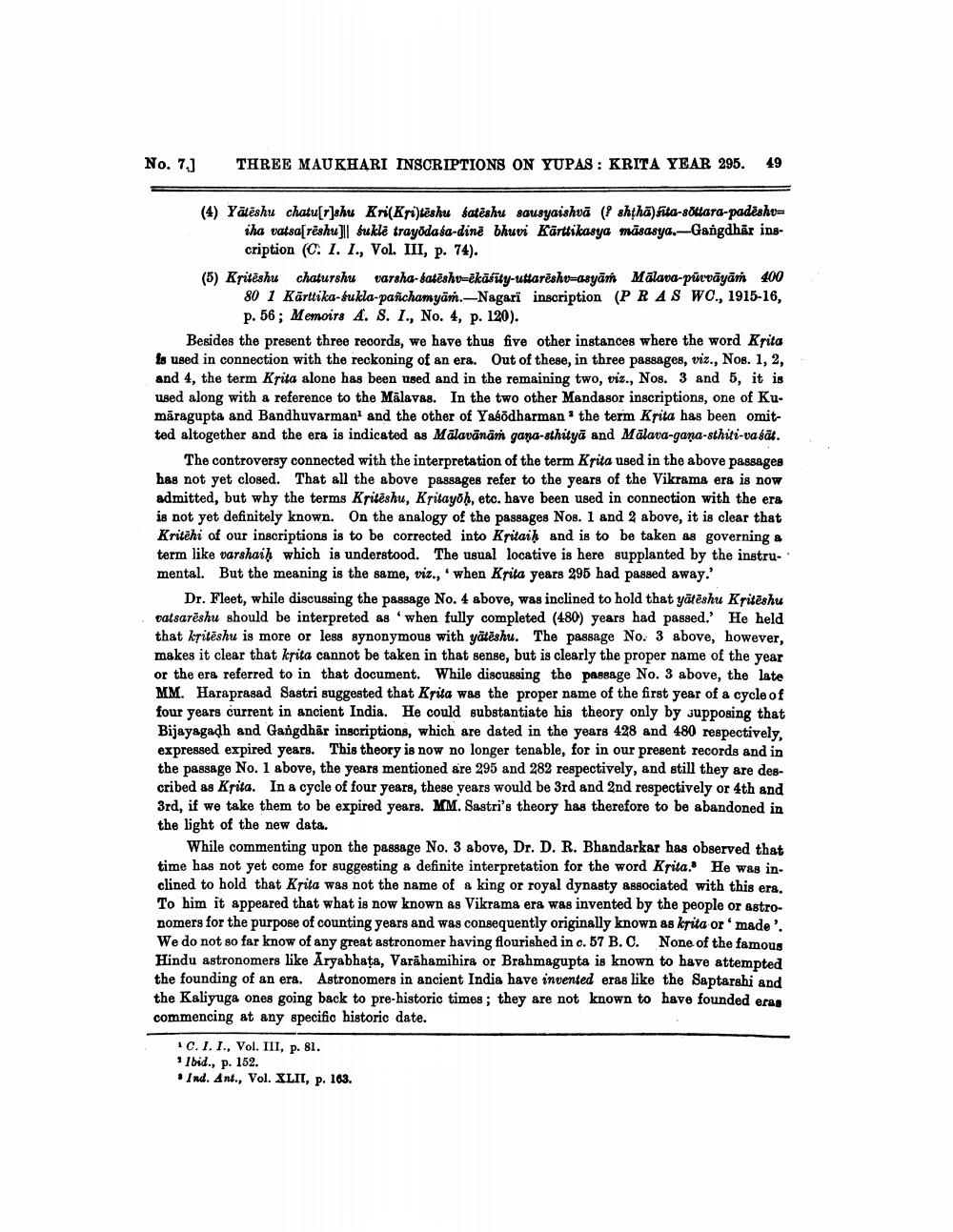________________
No. 7.]
THREE MAUKHARI INSCRIPTIONS ON YUPAS : KRITA YEAR 295. 49
(4) Yatëshu chatuftshu Kri(Kri)teshu katēshu sausyaishvā (9 shtha) fita-8őttara-padeshu=
iha vatsa[rëshull $ukle trayodasa-dinë bhuvi Kārttikasya māsasya.-Gangdhär ins
cription (C. 1. I., Vol. III, p. 74). (5) Kritēshu chaturshu varsha-latēshv=ékäsity-uttarësho=asyām Mālava-purvāyāṁ 400
80 1 Kārttika-tukla-pafchamyāń.-Nagari inscription (PR AS WC., 1915-16,
p. 56; Memoirs 4. 8. 1., No. 4, p. 120). Besides the present three records, we have thus five other instances where the word Krita Is used in connection with the reckoning of an era. Out of these, in three passages, viz., Nos. 1, 2, and 4, the term Ksita alone has been used and in the remaining two, viz., Nos. 3 and 5, it is used along with a reference to the Mālavas. In the two other Mandasor inscriptions, one of Kumāragupta and Bandhuvarman and the other of Yabodharman. the term Krita has been omitted altogether and the era is indicated as Malavānām gana-sthityā and Mälava-gana-sthiti-va sat.
The controversy connected with the interpretation of the term Krita used in the above passages has not yet closed. That all the above passages refer to the years of the Vikrama era is now admitted, but why the terms Kritēshu, Kritayoh, etc. have been used in connection with the era is not yet definitely known. On the analogy of the passages Nos. 1 and 2 above, it is clear that Kritēhi of our inscriptions is to be corrected into Kritaik and is to be taken as governing a term like varshai” which is understood. The usual locative is here supplanted by the instru-' mental. But the meaning is the same, viz., 'when Krita years 295 had passed away.'
Dr. Fleet, while discussing the passage No. 4 above, was inclined to hold that yātēshu Kritēshu vatsarēshu should be interpreted as 'when fully completed (480) years had passed.' He held that kritēshu is more or less synonymous with yātēshu. The passage No. 3 above, however, makes it clear that krita cannot be taken in that sense, but is clearly the proper name of the year or the era referred to in that document. While discussing the passage No. 3 above, the late MM. Haraprasad Sastri suggested that Krita was the proper name of the first year of a cycle of four years current in ancient India. He could substantiate his theory only by supposing that Bijayagadh and Gangdhār inscriptions, which are dated in the years 428 and 480 respectively, expressed expired years. This theory is now no longer tenable, for in our present records and in the passage No. 1 above, the years mentioned are 295 and 282 respectively, and still they are described as Kpita. In a cycle of four years, these years would be 3rd and 2nd respectively or 4th and 3rd, if we take them to be expired years. MM. Sastri's theory has therefore to be abandoned in the light of the new data.
While commenting upon the passage No. 3 above, Dr. D. R. Bhandarkar has observed that time has not yet come for suggesting a definite interpretation for the word Krita. He was in. clined to hold that Krita was not the name of a king or royal dynasty associated with this era. To him it appeared that what is now known as Vikrama era was invented by the people or astronomers for the purpose of counting years and was consequently originally known as krita or made'. We do not so far know of any great astronomer having flourished in c. 57 B.C. None of the famous Hindu astronomers like Aryabhata, Varāhamihira or Brahmagupta is known to have attempted the founding of an era. Astronomers in ancient India have invented eras like the Saptarshi and the Kaliyuga ones going back to pre-historic times, they are not known to have founded era, commencing at any specific historic date.
10.1.1., Vol. III, p. 81.
Ibid., p. 152. • Ind. Ant., Vol. XLII, p. 163.




